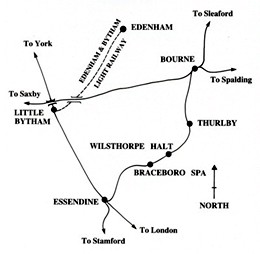|

The
railways in Bourne
BOURNE TO SAXBY & BOURNE
TO ESSENDINE
The coming of
the railway during the 19th century gave the people of Bourne fast access to other parts of Britain and turned the town into a rail junction where two lines crossed. The building of a track to connect the town with the Great Northern line at Essendine was completed in 1860 when the route was opened for both passengers and goods traffic, an undertaking that was not a particularly difficult engineering feat because the 6½ mile stretch of line needed no tunnels and there were no demanding gradients.
The Midland and Great Northern Railway Company had already bought the Red Hall and adjacent land and Bourne railway station was developed on that site
to cater for a business that was quickly expanded by the opening of the line to Spalding in 1866 which gave a direct connection from Melton Mowbray in the west as far eastward as King's Lynn and Cromer in Norfolk.
|
 |
|
The railway station
at Bourne pictured in 1950 (above). It was a busy station with
billboards advertising seaside excursions to Hunstanton, Skegness,
Sheringham, Cromer and Great Yarmouth. The buildings on the
central platform were installed by the Great Northern Railway in
1892 during an improvement programme costing £3,000 [almost
£200,000 in today's money] after complaints from passengers that
the small stand that existed did not provide sufficient cover from
the wind and rain, the new "handsome and commodious structure"
being modelled on that in use at Essendine station. Other work
carried out at the same time included extending the north platform
with the addition of refreshment and waiting rooms, a parcels and
booking office.
There was also a
well-stocked bookstall which can be seen in the picture from 1900 (below)
and the man standing on the
right is thought to be the manager at that time, Mr Ernest Harvey Smallman. |
|
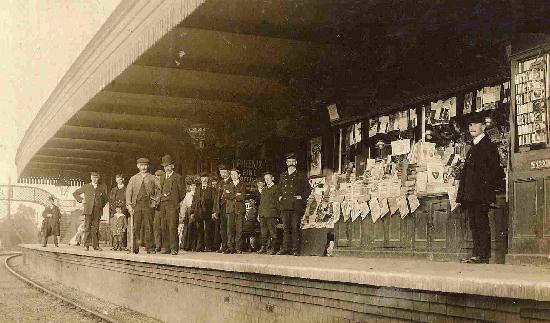 |
Details of the Bourne to Essendine rail
link were reported in the House of Commons by the examining committee in
June 1857 when it was announced that the proposed capital of the company
was £48,000, one third of which (£16,000) was to be taken up by a loan.
The amount subscribed in shares was £33,990 of which £3,399 had already
been deposited. The length of the proposed railway was 6 miles, 2
furlongs, 8½ chains, and the steepest
gradient was 1 in 107. It was intended to cross three roads on the level.
The estimated cost of the railway was £45,000 and the quantity of land
required 53¾ acres. The engineer was Mr W Hurst and the committee were
satisfied of the fitness, from an engineering point of view, of the
proposed railway.
The bells of the
Abbey Church rang out on Saturday 1st August 1857 to celebrate the passing
of the bill by the House of Lords, although still awaiting the Royal
Assent, and it was assumed that work would begin once the harvest was over
and sufficient labour would be readily available. But it was by no means a
fait accompli as the Stamford Mercury reported on
Friday 7th August:
The importance of the railway to a
town like Bourne, so that it may be placed in early communication with a
direct link like the Great Northern, is understood by all: it is in fact
necessary to enable the place to compete in every branch of trade with
other agricultural towns. It is proper to remark, however, that although
the Act of Parliament is virtually obtained, the line cannot be proceeded
with so rapidly as is desirable without adequate means and it is therefore
hoped that all parties locally concerned will lend their support to its
accomplishment. We are told that unless more shares are taken much delay
may occur. The active provisional committee, who have surmounted many
difficulties, will probably shortly commence a personal canvas to solicit
further influence and support.
Work was eventually well underway on the line by 1859 and excited great public interest in the
town, the events being closely followed by the Stamford Mercury
which reported on Friday April 15th:
The works of this useful branch from the Great
Northern to the town of Bourn, through a rich agricultural district, are
now progressing rapidly, not only in the continuation from the starting
point at Essendine going on, but workmen are now busily engaged both at
Bourne and at Thurlby, and the completion of the line may be anticipated
within the shortest time possible, and at an amount of expenditure which
can leave no doubt of its being satisfactorily remunerative to the
shareholders from the traffic which may be calculated upon with certainty,
and more so by the increase of traffic which a branch such as this may
safely be expected to produce. It is now determined that the Red Hall,
late the property of Sir P D P Duncombe, Bart., will be converted into a
station for Bourn. It is said that the hall, without being pulled down,
will make a convenient station, the entrance being from the South Street,
at the porter's lodge, along the site of the original carriage road to the
hall. Now that the line is being proceeded with at both ends and in the
middle, it may be truly said we "look like business", and it is hoped that
those capitalists who have not yet taken shares, and who desire the
prosperity of the town and trade of Bourn, will avail themselves of the
opportunity of taking up the remaining shares, and thus assist in
completing the project with the least possible delay.
Early the following year, work on the line was
proceeding rapidly towards completion and the newspaper reported on Tuesday 21st
February 1860 that:
An engine for the first time reached the Bourne station. In
the course of the afternoon, two of the company's directors, the Rev J Dodsworth and Mr E Hardwicke, together with Mrs and Miss Dodsworth, rode
the whole distance from the station at Bourne to the ballast hole near Essendine and back upon the tender of the engine. The whole journey is
said to have been performed in first-rate style, some part of it at the
rate of 40 miles per hour, and without any casualty. The line is now
nearly finished, except the levelling &c. of the station yards, and it is
expected that it will be ready for goods and coal traffic in the course of
three weeks or a month.
The
line finally opened in May 1860 after it had been officially tested
by Colonel Yolland, the government Inspector of Railways when the Stamford
Mercury reported that "he expressed himself well satisfied with its
construction, which he pronounced to be one of the best lines upon which he had
travelled". The newspaper report on Friday 4th May continued:
The
inspector, accompanied by some of the officials of the Great Northern Railway,
an engine, a brake-van and one carriage, arrived at Bourne station at about
½past 12 o'clock [on 30th April] and on alighting, proceeded to the Abbey,
where they partook of luncheon with the Vicar, and afterwards left Bourne on
their return trial trip, accompanied by some of the directors and their friends.
We have reason to believe that the Inspector's report to the Board of Trade will
be favourable and that in a few days, the necessary certificate will be received
by the directors, giving permission to open the line for passenger traffic. Now
that the Bourne and Essendine railway may be fairly termed an accomplished fact,
those persons who desire to promote the welfare of the town and trade of Bourne will stand the best chance of attaining that objective by assisting in the
endeavour about to be made to improve the markets and fairs. At the opening of
the line, the inhabitants of Bourne will, it is believed, fraternise at a public
dinner.
The
date of May 10th was fixed for the opening but the line's official certificate
of competence had not arrived and so it was postponed and passenger services
actually began on Wednesday 16th May. Sightseers gathered at Bourne station to
witness the first departure at 9 a m, a train pulling five carriages but only 35
passengers. The church bells rang throughout the day to mark the occasion
although there were no other formal celebrations and the public dinner that had
been promised did not materialise.
Surveyors began mapping out the route of the line between Bourne and Sleaford in
February 1870 and it was eventually opened in 1872, giving access to the northern parts of Lincolnshire and, more importantly, trains began to run between Bourne and Little Bytham junction in 1894, from where the track continued to Saxby and this east-west route became the most important of the lines which served the town, carrying a considerable amount of both passenger and freight traffic. Thus within the space of just over thirty years, Bourne had become a railway centre of some importance.
|
 |
|
The railway station complex at Bourne circa
1900 |
|

|
|
A passenger train
leaving Bourne station on the line to Sleaford (above), pictured from the
level crossing in South Street with the Red Hall in the
background, circa 1890.
The picture below shows the Yarmouth to Leicester express
leaving Bourne in 1950. |
|
 |
The boom was not to last and despite protests from local people, the last passenger train
from Spalding ran on 28th February 1959, and freight facilities for the movement of sugar beet disappeared in 1965, virtually ending the railway age for Bourne. The platforms were demolished and the remaining red brick station buildings are now part of the central depot and offices of Wherry and Sons Ltd., the agricultural merchants who have been associated with the town since the early 19th century.
Many of the railway stations in the surrounding villages also survive, some converted for use as business premises or private homes, while evidence of the great steam age is all around us.
The railway station at Rippingale was built in 1871 and opened for goods traffic on the line between Bourne and Sleaford in October of that year while passenger trains started running the following January. The services closed completely almost a century later and the Victorian building through which generations of travellers had passed has since been turned into a private house but many of the artefacts of the steam age can still be seen in the vicinity. The solid red brick building which stands in Fen Road almost a mile outside the village
has been sympathetically restored and extended but has retained its original appearance and the platform is intact although the rails and sleepers have been removed but the old British Railways sign still hangs on the wall.
The village lost its passenger service on 22nd September 1930 which was quite an event at the time because ninety-nine stations and seventeen lines closed nation-wide on that day. The line and the station however remained open for goods and special passenger trains, the last of which was in 1951 when local people were picked up here for a visit to the Festival of Britain in London. Potatoes, grain and sugar beet were carried along the track in the ensuing years until the final closure came on 15th June 1964.
The old goods shed and other outbuildings remain on site and are also being renovated by the owner, railway enthusiast John Scholes, while rails and sleepers are neatly piled up nearby. One short stretch of track can also be seen with a steam locomotive standing on the rails, once rusting and deteriorating but for this engine, it may not be the end of the line because it is now being restored. This steam engine is in fact an Avonside locomotive, Works No 1972, built in 1927, and called
Dora and will soon be moved into the goods shed for further refurbishment work. It was once in service with the Ketton Cement Company which is based near the town but was purchased by Mr Scholes when its working days were over. The
Dora is sister to a consecutive locomotive called Stamford which is currently in service at the Rutland Railway Museum.
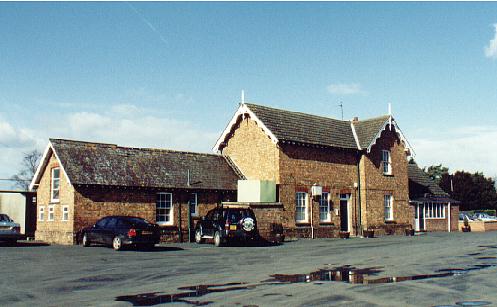 |
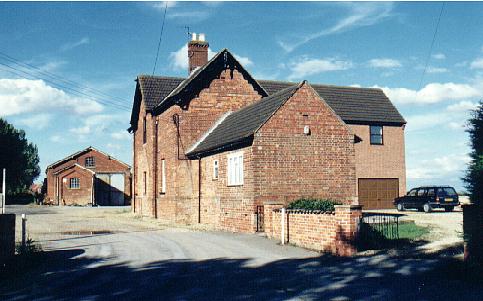 |
|
The
old railway stations at Billingborough (left), now headquarters to
a haulage firm,
and
at Morton (right), now a private home. Both were built circa 1872.
See also Morton village for a glimpse of
how the station used to look. The picture below shows the viaduct carrying the line across the main road at
Little Bytham.
|
|
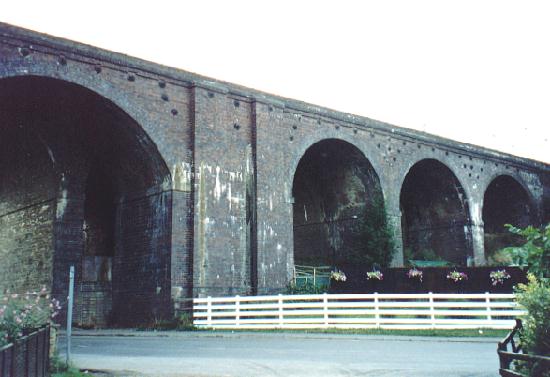 |
Little Bytham is perhaps the most important reminder of the railway steam age in the area. The tiny village on the B1176 four miles south west of Bourne, is famous among railway buffs because it nestles around a grand Victorian viaduct that carries the main east coast line between London and Scotland. It was on this stretch of track between Grantham in Lincolnshire and Peterborough on 3rd July 1938 that the L N E R 4-6-2 locomotive No 4468 Mallard hauling seven coaches weighing 240 tons achieved the highest speed ever ratified for a steam locomotive of 126 m p h over a distance of 440 yards. Driver Joseph Duddington was at the controls with Fireman Thomas Bray and the engine suffered severe damage as a result.
The 16th century hostelry in the village High Street below the arches was originally known as
the Green Man but because of the growing interest in railways and the steam engine record, it was changed to the Mallard in 1978
although it closed in 2002 and is now a private residence. The viaduct is still in use and inter-city express trains rather than steam engines now thunder past at regular intervals.
The Victorian railway station at Morton has a similar history to the one at Rippingale and is of the same design and construction. It was built on the outskirts of the village around 1872 when the railway line between Bourne and Sleaford was opened and it closed when freight traffic was terminated in 1964. The solid red brick property has since been turned into a private residence and the platform has been removed to make way for an additional wing to the house together with two garages although the engine shed and other outbuildings remain nearby.
The railway station at Billingborough also survives but is used as a haulage depot, the station at Essendine has been converted for use as business premises and at Braceborough, one of the two intermediate stations on the Bourne-Essendine branch line, only the station house remains as a private house and has been renamed Spa Halt. At Twenty, the station has been converted for use as a double glazing workshop while at Thurlby, the site is now a council depot and only the platform remains.
It is also possible to trace the route of the line between Bourne and Sleaford by the distinctive white-painted gate keepers' cottages erected at the site of level crossings. All have now been sold as private homes and the first can be seen where a level crossing was installed for the M & G N line where it crossed the Austerby south of
Bourne station on its way to Twenty and Spalding and then into Norfolk. The present owners of the property have called their home The Gatehouse and added a distinctive plaque with a picture of a red steam engine on the front wall to remind passers-by of its previous history. There is another such cottage of similar date and design in Mill Drove at its junction with Stephenson Way and others can be found at Dyke, Rippingale and Pointon.
Also in the Austerby on the opposite side of the road is Number 15, a substantial red brick building which was formerly an inn with a name bearing witness to the emergence of a new era, the Railway Tavern. The property was built in 1720, and so the hostelry had another name before the coming of the railways. It still contains many of the characteristic features of an old inn such as a door with a keyhole only on the inside, a well in the yard and the old brewery in an outbuilding at the back. The public house closed in 1901 and has been a private residence ever since. Its demise as an inn was probably due to a lack of trade caused by competition from other hostelries in the town.
The coming of the railways and the subsequent withdrawal of services in country areas as a result of the Beeching axe in 1963, which sounded the death knell for so many rural and branch lines to concentrate resources on inter-city passenger traffic and freight, are as much a part of our heritage as the old buildings we see around us because they are a reminder of a less hurried and more relaxed way of travelling before our roads became congested and our urban environment polluted by the motor car. It is one of the great travesties of our time that when these highly popular and well used country routes were closed, the decision was made irrevocable by the removal of the iron rails and so now when we need this method of public transport so badly, there is no going back.
|
WELCOME
TO THE STEAM AGE
The
new line between Bourne and Saxby was completed by the Midland
Railway Company in 1893 and brought greatly improved rail communications from east to west. Regular passengers services did not begin using the line until the spring of 1894 and by then, freight traffic was already well established, the first train passing through on 5th
June 1893. The event was given significant coverage in the Stamford Mercury whose report also contained interesting examples of the construction methods in use during the late 19th
century:
The first goods train from Leicester to Lynn on the new line passed through Bourne about seven o'clock on Monday morning. This marks the completion of the railway extension opening up direct communication between the Midlands and South Lincolnshire. The work has been two years in progress. The Saxby section, connecting the Leicester and Peterborough branch of the Midland Railway, has been opened some time. The Bourne section, connecting the Midland system with that of the Great Northern by the Essendine branch, presented several engineering difficulties.
At Little Bytham, the Great Northern line is crossed by a girder bridge, with a single span of nearly 100ft. There are fine brick-arched bridges over the public roads and over the river Glen. A lofty and imposing-looking viaduct crosses the Vale of Lound. Extensive cuttings have been excavated and high embankments raised. Bourne is approached by a tunnel 330 yards long, bored through the Stamford Hill. The extension has been effected by the Midland and Great Northern Companies conjointly and the concluding section entailed heavy expenditure. Mr William Mousley, Brockton Hall, Eccleshall, was the contractor. For the Vale of Lound viaduct, Messrs Kingston supplied one-and-a-half million Bourne red bricks, and for the Bourne Tunnel, two-and-a-half million. The whole of the work is faced with Staffordshire blue bricks. The new line comprises 13 miles of single and five miles of double rails, the former belonging to the Midland and the latter to the Midland and Great Northern conjointly.
It will materially reduce the distance between the Midland Company system and its connection with Bourne, Spalding, King's Lynn, Cromer, Norwich and Yarmouth. The new stations between Saxby and Bourne are Wymondham and South Witham and it is hoped that another will be constructed at Bytham and a siding at Lound. The new siding will probably be opened for passenger traffic within a month. In view of the development of local trade, the line has been doubled to Twenty, three miles beyond Bourne, on the joint line.
One part of this work, the construction of a bridge beside that at present spanning the Bourne Eau, involved the expenditure of several thousand pounds. This bridge is 302 feet in length and is constructed of girders resting on 20 cast iron cylinders. Each of the cylinders is 4ft in diameter and about 40ft long. Their total weight is about 160 tons. The peaty fen soil had to be penetrated to a depth of 40 to 50 feet in order to reach the firm foundation of the Oxford clay, which constitutes in this locality the bed of the fens. The cylinders were all put down under compressed air. The earth removed from the inside of the cylinders was replaced with concrete, the whole being surmounted with a massive plate which carries the girders. These girders are of steel, weighing 88 tons. Nearly 50 tons of steel were required for the trough flooring which was filled with asphalte concrete. This work has taken seven months, the contract being executed by Mr M Pitts of Stanningley, Leeds. Mr Pitts, junior, acting as erector. Mr T Bennett has officiated as agent for Mr Mousley in the Bourne and Saxby line and the work has been carried out under Mr J Allen McDonald, chief engineer of the Midland Company, Mr George C McDonald being the resident engineer at Bourne.
The The
Railway News subsequently reported that the total cost of the line
constructed by the Midland Railway Company between Leicester and
Norwich, passing through Ashwell and Bourne, was £550,000 plus a
further £2,000 for station buildings at Bourne.
|
|
DEATH OF THE STATION
MASTER
The
post of station master was an important one and those who held it
enjoyed a considerable standing in the community. It was unusual
for anyone to die in office and when this occurred in Bourne in
the early 20th century, the funeral was a big public
occasion as reported by the Stamford Mercury on Friday 19th June
1908.
We
regret to have to record the death of Mr W H Clarke, which took
place on Sunday. Mr Clarke had been off duty since the last week
in February, and all that time had more or less been confined to
his bed. Just before Whitsuntide he was well enough to undertake a
journey to Folkestone, which it was hoped would materially improve
his condition, but at the end of the month he returned home, to
the regret of all his friends, in a weaker condition than when he
went away. Mr Clarke, who had been at the station only about
two-and-a-half years, succeeded Mr Herbert Brader in January 1906, came
here from Horncastle, and by his genial manner soon gained a
circle of friends. He was no stranger to the district, as he had
previously held a similar position at Morton-road. Mr Clarke, who
was 54 years of age, leaves a widow and one daughter, for whom on
every hand are the deepest expressions of sympathy. The funeral
took place at Bourne Cemetery on Wednesday. The coffin, of
polished oak with brass fittings, was borne by six of the railway
employees in uniform. In addition to the members of the family
there were present:- Messrs Eveleigh (Horncastle), Wilson
(Boston), Brader (Lincoln), Mouncey (Spalding), Cox, Fowler,
Fulstone, Mills, Adams, Brown (Bourne), Towell (Horncastle), and
Mr H A Halliday, acting station master at Bourne, the
railway officials and employees, Messrs W R Leary, G Frost,
(representing Messrs Foley), and C J Phillips &c. The service
was conducted by the Rev H M Mansfield. There was a splendid array
of floral tributes from members of the family and friends
including a very beautiful one from the railway staff at
Bourne.
See also James
Edward Fisher |
|
FROM THE ARCHIVES
RAILWAY ACCIDENT: The return excursion train
which was due to leave London at ten minutes before twelve on
Saturday night last arrived at Bourne between three and four o'clock
on Sunday morning. When near the platform at Bourne station the
engine came into violent collision with two empty carriages which
were standing upon the line, driving them completely through two
very strong gates at the South Street crossing, one of the gates
being smashed to splinters, and the carriages considerably damaged.
There were nine passengers (including two ladies) in the carriage
attached to the engine and we have not heard of anyone sustaining
greater injury than a severe shaking. One gentleman's hat was
smashed to such an extent that he has put in a claim for a new one.
- news report from the Grantham Journal, Saturday 5th April 1873.
THE OLDEST GUARD ON THE MIDLAND RAILWAY, John Wrigglesworth, died
on Friday week at his residence, Woodview, Bourne, at the age of
seventy-one. Until the past three weeks he had regularly performed
his duties. He had been in the Midland Company's service since its
formation, and for almost half a century his figure has been
familiar between Leeds and St Pancras. During the earlier part of
his railway career he resided at Leeds. For twenty-six years he
resided at Peterborough and for the past four year, while acting as
guard between Bourne and Saxby, he has lived at Bourne. He was
popularly known as "Old Matty" and, alike by officials and
employees, was held in high respect. Both in his bluff, frank,
hearty manner and in his strikingly picturesque appearance, he was
the very presentment of a typical sea captain in Nelson's day. The
interment took place in Bourne cemetery on Sunday morning and the
funeral cortege comprised a large number of railway officials and
employees. The service was impressively conducted by the vicar, the
Rev H M Mansfield. - news report from the Grantham Journal,
Saturday 17th June 1899. |
See
also
More old photographs from the
golden age of steam
The
1856 Prospectus to the Bourne & Essendine Railway Company

Go to:
Main Index Villages
Index
|


